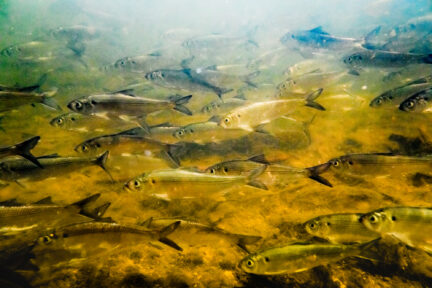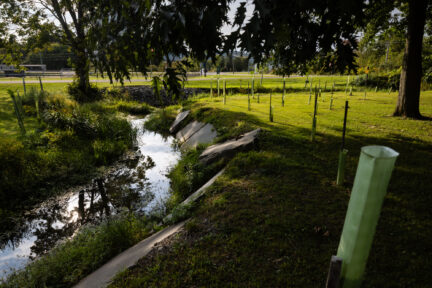Water Quality in Chesapeake Bay Approaches Record High
Water Quality in Chesapeake Bay Approaches Record High
The Chesapeake Bay Program announced today that estimated water quality in the tidal Chesapeake Bay has reached a near-record high. According to preliminary data, almost 40 percent of the Chesapeake Bay and its tidal tributaries met clean water standards for clarity, oxygen and algae growth between 2014 and 2016. This two percent increase from the previous assessment period is due in large part to a rise in dissolved oxygen in the deep channel of the Bay.
While this positive sign of resiliency in the nation’s largest estuary indicates our ecosystem has recovered from the damages sustained during Hurricane Irene and Tropical Storm Lee, water quality must improve in 60 percent of the Chesapeake Bay and its tidal tributaries if the estuary is to function as a healthy ecosystem. Local efforts to reduce nutrient and sediment pollution have shown some success under the Chesapeake Bay’s “pollution diet,” but the challenge of putting enough conservation practices on the ground to further reduce agricultural runoff and urban runoff to local waterways remains.
The Chesapeake Bay Program partnership uses several environmental indicators to track pollution and assess aquatic health. A suite of computer simulations called the Watershed Model is used to estimate the impact that local conservation and best management practices have had on nutrient and sediment loads. Monitoring data collected from stations on the nine largest rivers in the watershed provide the foundation for experts to estimate the total nitrogen, phosphorus and sediment entering the Chesapeake Bay and its tidal tributaries each year, while data collected from stations in non-tidal waters allow experts to assess the aquatic response to efforts to reduce agricultural and urban runoff. Additionally, monitoring data is also collected from a comprehensive network of hundreds of stations in tidal waters to assess changes in water quality.
Computer simulations show that best management practices are currently in place to achieve 33 percent of the nitrogen reductions, 81 percent of the phosphorus reductions and 57 percent of the sediment reductions necessary to achieve the pollution-reducing commitments of the Chesapeake Bay Watershed Agreement. In 2016, Chesapeake Bay Program partners surpassed their phosphorus- and sediment-reducing goals. Nitrogen reductions, however, fell short of the target for the fourth year in a row, due in large part to a gap in reported and implemented agricultural best management practices in Pennsylvania. At the 2016 meeting of the Chesapeake Executive Council, the U.S. Department of Agriculture and U.S. Environmental Protection Agency announced their intent to increase funding, technical assistance and direction for Pennsylvania in order to increase the implementation of nitrogen controls in the Commonwealth.
Findings based primarily on monitoring data collected at nine River Input Monitoring (RIM) stations reveal inconsistent trends in pollution loads.
- In the District of Columbia, the Potomac RIM station has experienced improving ten-year trends in nitrogen but degrading ten-year trends in phosphorus.
- In Maryland, one station—in the Patuxent—has experienced improving ten-year trends in nitrogen and phosphorus. The Susquehanna station has experienced degrading ten-year trends in nitrogen and phosphorus; the Patuxent station has experienced degrading ten-year trends in sediment; and the Choptank station has experienced degrading ten-year trends in nitrogen, phosphorus and sediment.
- In Virginia, both the James and the Rappahannock stations have experienced improving ten-year trends in nitrogen. The Mattaponi station has experienced degrading ten-year trends in nitrogen and phosphorus; the Pamunkey station has experienced degrading ten-year trends in nitrogen and sediment; and the Appomattox station has experienced degrading ten-year trends in nitrogen, phosphorus and sediment.
Monitoring data collected from non-tidal stations throughout the watershed show that half of the stations analyzed for nitrogen, 38 percent of the stations analyzed for phosphorus and 20 percent of the stations analyzed for sediment have experienced improving ten-year trends. Thirty-one percent of the non-tidal stations analyzed for nitrogen, 26 percent of those analyzed for phosphorus and 37 percent of those analyzed for sediment have experienced degrading ten-year trends.
While data also show that pollution loads in 2016 remained below the long-term average, these loads did increase: between 2015 and 2016, nitrogen loads increased 12 percent to 241 million pounds, phosphorus loads increased 35 percent to 13.6 million pounds and sediment loads increased 56 percent to 2.5 million tons. Experts attribute this rise to an increase in river flow, which itself is affected by rainfall.
Improvements in water quality will take time, and there are often lags between the implementation of best management practices and the visible effects of those practices on a particular waterway. In January, the Chesapeake Bay Program will release the 2016-17 Bay Barometer: Health and Restoration in the Chesapeake Bay Watershed, which will explore how the entire Chesapeake Bay ecosystem and its watershed are responding to the partnership’s collective protection and restoration efforts.
Facts
The U.S. Geological Survey (USGS) works with state partners to monitor nitrogen, phosphorus and sediment loads entering the Chesapeake Bay from nine River Input Monitoring (RIM) stations, which together reflect the nutrient and sediment loads delivered to the Bay from almost 80 percent of its watershed. To estimate pollution loads delivered from the remaining 20 percent of the watershed, the Chesapeake Bay Program partnership pairs this data with nutrient levels in water samples collected at wastewater treatment plants, computer-simulated estimates of nutrient loads from nonpoint pollution sources and computer-simulated estimates of the atmospheric deposition of nitrogen to tidal waters. The USGS also determines long-term and short-term trends in nutrient and sediment loads, and works with the U.S. Environmental Protection Agency (EPA) and state partners to collect monitoring data at more than 100 non-tidal monitoring stations to assess the aquatic response to efforts to reduce agricultural and urban runoff.
Each year, Delaware, Maryland, New York, Pennsylvania, Virginia, West Virginia and the District of Columbia report the steps they have taken to reduce the nitrogen, phosphorus and sediment loads entering rivers and streams to the EPA. Chesapeake Bay Program experts run this information through a suite of computer simulations known as the Watershed Model to determine how far its partners have come toward meeting the pollution reductions outlined in the Chesapeake Bay’s “pollution diet,” or Total Maximum Daily Load (Bay TMDL). Chesapeake Bay Program partners have committed to having 100 percent of the practices that would achieve all of the nutrient and sediment reductions necessary to meet the Bay’s clean water goals in place by 2025, with those practices that would achieve 60 percent of the necessary nutrient and sediment reductions in place by 2017.
These pollution load estimates, which are derived from land use and best management practice implementation, are just one in a suite of tools the EPA uses to evaluate whether jurisdictions are on track to meet the Bay TMDL and its two-year milestone commitments. The EPA also considers data and information on best management practice implementation, best management practice effectiveness and jurisdictions’ progress toward putting programs in place to achieve pollution cuts.
Water quality in the Chesapeake Bay and its tidal tributaries is evaluated using three parameters: dissolved oxygen, water clarity or underwater grass abundance, and chlorophyll a (a measure of algae growth). These parameters are monitored at hundreds of stations across the Chesapeake Bay and its tidal tributaries by the Maryland Department of Natural Resources, the Virginia Department of Environmental Quality and the District Department of Energy and Environment. The resulting data is used to develop an indicator of the estimated attainment of a set of water quality standards that can be monitored at this time. If the Bay and its tidal tributaries are to function as a healthy ecosystem, all water quality standards for all tidal aquatic habitats must be met.
Issues
Excess nutrients and sediment are among the leading causes of the Bay’s poor health. Nitrogen and phosphorus can fuel the growth of algae blooms that lead to low-oxygen “dead zones” in deep waters and short-duration “mortality moments” in shallow waters. Sediment can block sunlight from reaching underwater grasses and suffocate shellfish. Pollution-reducing practices used in backyards, in cities and on farms can lower the flow of nitrogen, phosphorus and sediment into waterways.
Quotes
“The improving trends in water quality standards attainment follow similar trends in other indicators that we track. The acreage of underwater grasses has increased to more than 50 percent of its goal. In addition, we are seeing an increase in the diversity of grass species and the density of grass beds. We also are witnessing improvements in several fisheries, including blue crabs, oysters and rockfish. While these improving trends are encouraging, we must ramp up our efforts to implement pollution control measures to ensure progress toward 100 percent of the water quality standards is achieved throughout the Bay and its tidal waters.”
-- Nick DiPasquale, Director, Chesapeake Bay Program
“Robust funding, science, and stewardship are paying off and cleaning up the Bay but we still have a long way to go. The states are committed to clean water progress for a healthier Chesapeake and the positive results we’re getting reinforce the need for continued, cost-effective investments and innovative partnerships.”
-- Ben H. Grumbles, Chair, Chesapeake Bay Program Principals’ Staff Committee, and Secretary, Maryland Department of the Environment
“Increases in water quality standards attainment is encouraging to see and suggest that the work of the Bay Program partnership in reducing pollutants is having the desired effect. But we must also recognize that our work is not finished. The upcoming midpoint assessment will give us the opportunity to assess what we’ve been doing and make any necessary adjustments. By adaptively managing, we will more effectively address the pollutant loads that are still flowing into the Bay and our local waterways.”
-- James Davis-Martin, Chair, Chesapeake Bay Program, Water Quality Goal Implementation Team, and Chesapeake Bay Coordinator, Virginia Department of Environmental Quality



